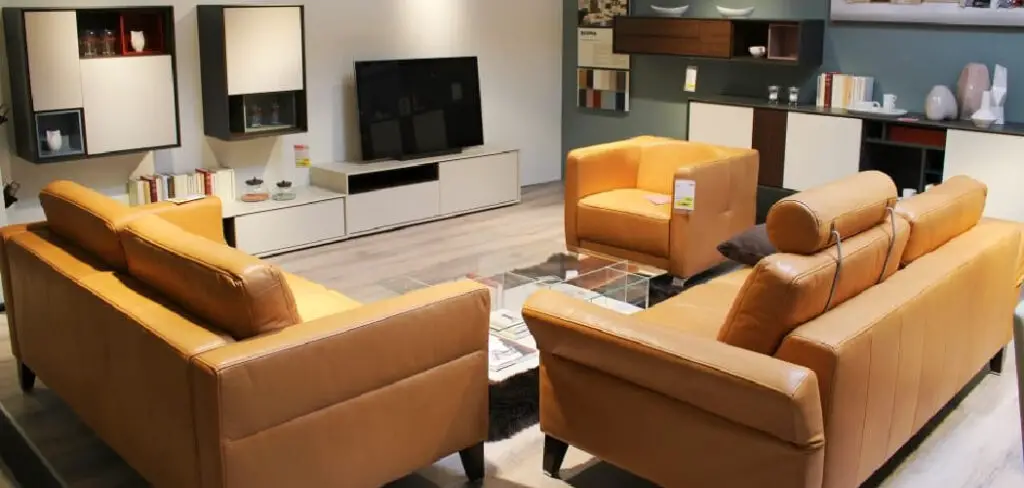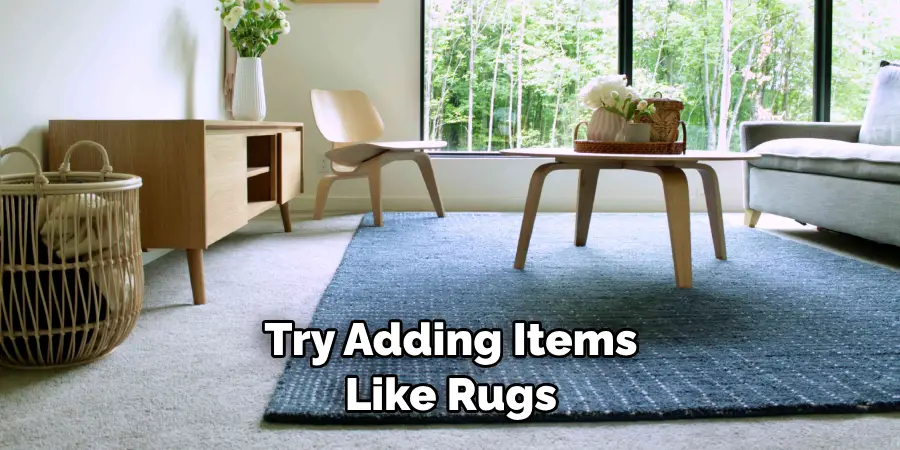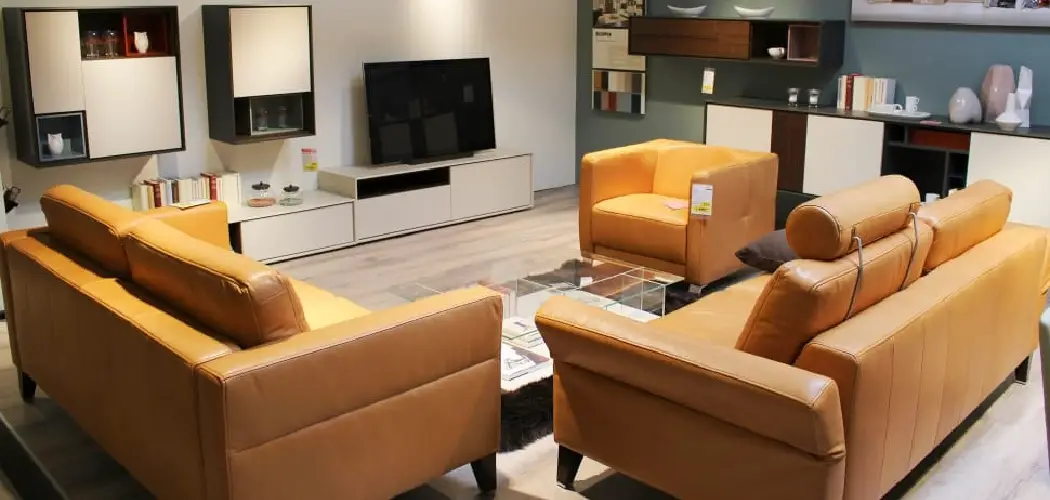Are you looking for a unique home decor style that stands out? Mixing leather and fabric furniture is the perfect way to create a stylish yet cozy atmosphere in your living room. With so many options available, it can be difficult to know where to start.

Keep reading if you want to learn how to mix leather and fabric furniture without clashing colors or styles! We’ll look at tips on what hues pair well together, how best to incorporate vintage elements and more—all geared toward creating the ideal balance of texture and color in your space.
11 Step-by-step Guidelines on How to Mix Leather and Fabric Furniture
Step 1: Choose Your Colors Wisely
Start by selecting a color palette that you like. A neutral base like beige, light grey or cream are all good options. This will create a softer, more inviting atmosphere and give you the freedom to experiment with brighter colors.
It’s also a good idea to pick colors that both complement and contrast each other. For example, navy blue furniture with white accents will work well together. Always consider how the tones will look together when deciding what colors to choose.
Step 2: Consider Your Space
Think about how much space you have in your living room. You want the fabrics and leather pieces to complement each other, without overcrowding or clashing with other furniture in the room.
But don’t be afraid to mix and match different styles together! You could go for a contemporary look with sleek, modern furniture or try a more eclectic approach with vintage pieces. It all depends on the style of your home and personal preferences.
Step 3: Balance Out The Textures
A great way to mix leather and fabric furniture is by balancing out textures. Choose one of each type of material (leather and fabric) for chairs, couches and ottomans. This will ensure that no single texture or color takes over the space.
If you want to add even more texture, try adding items like rugs and pillows in both leather and fabric. Place these strategically around the room- this will help to break up the monotony of having all one material. This is also a great way to bring in some pops of color to the room.

Step 4: Go For Contrasting Colors
When choosing different pieces of furniture, go for contrasting colors. For instance, pair a light-colored leather chair with a dark-colored fabric couch or opt for different shades of the same color.
It’s important to make sure that the pieces are similar enough in size and shape so they don’t clash too much. Softer colors will add warmth to the room, while brighter shades can create a more vibrant atmosphere. It all depends on the kind of atmosphere you’re looking for!
Step 5: Incorporate Vintage Elements
Vintage elements, such as antique rugs and vintage armchairs, can be great additions to your living room. The combination of contemporary pieces and vintage items creates an interesting contrast that is sure to add character to the overall design.
If you opt for vintage furniture, be sure to choose pieces that are still in good condition. But don’t forget to incorporate new pieces too! This will help to anchor the space and tie everything together.
Step 6: Choose Coordinating Accessories
Complete the look by adding coordinating accessories. Pillows, throws and curtains in complementary colors will help tie the space together while also providing comfort and warmth. It’s also a great way to bring in pattern and texture. But remember- less is more! Too many accessories can make a room look cluttered and overwhelming.

Step 7: Play With Patterns
Don’t be afraid to try out different patterns. Mixing and matching floral, stripes and geometric designs can create an eye-catching look that’s truly unique. It’s best to stick with two or three patterns and colors, as too many can be distracting.
This is also a great way to make your space feel inviting and cozy. This is especially true if you opt for fabrics with a plush, velvet-like feel. You can also add texture to the room with textured leather furniture.
Step 8: Consider Texture
Texture plays a key role in any interior design scheme. Incorporate leather pillows with fabric sofas or opt for suede armchairs with velvet-covered cushions to add interest and depth to your space.
You can also add texture by incorporating different materials such as wood, metal and glass. It’s all about creating a balance between different materials and textures. However, make sure you don’t go overboard – too much texture can be overwhelming.
Step 9: Add Architectural Elements
Architectural elements such as exposed brick walls, ornate mirrors or rustic beams can bring the entire room together while giving it a sense of personality. It’s important to choose pieces that will complement the overall design- don’t be afraid to think outside of the box! But be careful not to overdo it- too many architectural elements can make the room feel cluttered.
So make sure to choose wisely. Adding just the right amount of architectural elements will help to tie together all of the different materials and textures.

Step 10: Lighten Up
Lighting is another important factor to consider when mixing fabric and leather furniture. Choose statement lighting pieces in hues that match the other elements of the room to make it feel more inviting and cozy. It’s also a great way to add interest and create a relaxing atmosphere. While you’re at it, don’t forget to bring in plenty of natural light too! This will make the room feel more airy and open.
Step 11: Create a Focal Point
Finally, pick out one or two focal pieces such as a fireplace or a bookshelf to draw attention to and act as the anchor for your living room design. These are great ways to add interest and create an overall cohesive look.
Always be sure to keep the focal point in mind when selecting the other pieces of furniture and accessories. If you follow these steps, you’ll be sure to create a living room that perfectly blends leather and fabric furniture.
By following these eleven tips, you’ll be able to mix leather and fabric furniture without clashing colors or styles. With this approach, you can create a stylish yet cozy atmosphere that is sure to be admired by all who enter!
Do You Need to Hire a Professional?
Mixing leather and fabric furniture is no easy task, and if you’re not sure where to start it’s best to consult with a professional. An experienced interior designer will be able to help you create the perfect look for your home while incorporating the pieces of furniture that you already have.
With these tips in mind, you can easily learn how to mix leather and fabric furniture without clashing colors or styles! Keep this guide handy so that your living room design ideas don’t get stuck in limbo. Have fun mixing different colors, patterns, and textures—and enjoy your beautiful new space!
Frequently Asked Questions
Q: What Colors Pair Well Together When Mixing Leather and Fabric Furniture?
A: Neutral colors such as beige, light grey or cream are all good options for a base. From there you can experiment with brighter colors to create contrast.
Q: How Do I Incorporate Vintage Elements Into My Living Room Design?
A: Vintage items such as antique rugs and vintage armchairs can add character to your space. Balance out the modern pieces with these unique elements to create an interesting contrast.
Q: What Accessories Should I Choose When Mixing Leather and Fabric Furniture?
A: Pillows, throws and curtains in complementary colors can help tie the space together. You can also add architectural elements such as ornate mirrors and rustic beams to create a more inviting atmosphere.

Q: Do I Need to Hire a Professional?
A: If you’re not sure where to start, it’s best to consult with an interior designer so that they can help you create the perfect look for your home. With their expertise, you’ll be able to mix leather and fabric furniture without clashing colors or styles!
Conclusion
Ultimately, mixing leather and fabric furniture is an incredibly versatile approach that allows you to curate a vibrant and comfortable space. Whether it’s a minimalist formal living room or an informal family room, the combination gives any space a unique touch and timeless quality.
Remember- even distantly related hues of fabrics can add a subtle tying element throughout the decor in your space. Get creative with textures, patterns, and colors for maximum effect! If you’re feeling overwhelmed, remember to try out combinations with virtual tools first and don’t be afraid to make mistakes as you test out different ideas.
Take it all one piece at a time too; it’s your home after all. Now that you know how to mix leather and fabric furniture, why not give it a try in your own home? Feeling inspired? Check out our next blog post on how to make sure your employees are working from home!

